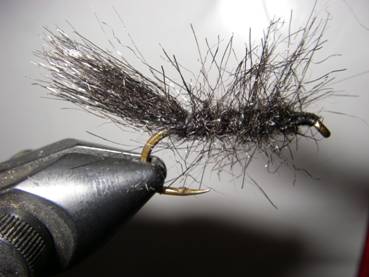HOW TO TIE A WOOLY BUGGER

You don't need to read this. You know how to tie a wooly bugger. It was one of the first flies you learned to tie, right? You tie in a tail of marabou, a saddle hackle and a length of chenille at the rear of the hook. Bring the thread and then the chenille to the head. Palmer the hackle forward and tie off. Finish the head and cut the thread. Head cement, tinsel and wire ribs are all options but that's the basic wooly bugger. But what if you don't have any marabou, hackle or chenille? You can do what I did for the fly in the picture if you have the material I used. More importantly if you if you understand the characteristics of materials you can tie one with what you have. And catch the same fish you would catch with a traditional wooly bugger.
Even if you own an entire fly shop you will never have every material called for in every pattern you see in a magazine or web site. If you are richer and more patient than I am you can always find and order those materials and wait for them to arrive. Alternatively you can analyze the fly to determine what the material contributes to the fly. Sometimes it is more to catch fishermen than fish and you can just eliminate it. Usually though the fly isn't going to work without it. That's when you have to examine the materials you do have and choose an effective substitute.
Materials used in a fly should be chosen for a purpose. They should add to the illusion of a living thing, often a particular living thing. They provide the shape and color of the fly but also determine if the fly will sink or float. The choice of material and how it is used determine how the fly rides in or on the water, if it has movement and what kind of movement. The first problem then is to determine what the material contributes to the fly. What are the important characteristics your substitute needs to have? You may not have anything that exactly replaces the material in question. Choosing your material then is matter of prioritizing the characteristics of both materials and matching the most important ones.
The importance of various characteristics will vary from fly to fly but I will offer a few generalizations.
First you have to consider the effect on the floatation or sinking of the fly. Is the material you are replacing important to that? After that you want the fly to have the right size and shape. Next consider the effect on the action of the fly. I include the way a dry fly rides on the water or in the film in that. Is it a flashy material or fuzzy or smooth and shiny? Is it rigid or chosen for movement? Other characteristics that can be important include absorbency, finish including patterning, and durability. Finally I will look at the color. If I can't match it exactly I think in terms of bright or dull and light or dark.
If you follow these guidelines you too can tie a wooly bugger. The fly in the picture. That came from trying to tie with the simplest material list possible. The tail is long fibers from black craft fur as is the hackle (placed in a dubbing loop) and the body is dubbed from the short fibers. Craft fur tends to float better than a regular bugger so it has to be weighted if you want it to sink.
For more great info, check out:
Beginning Fly Tying | Intermediate Fly Tying | Advanced Fly Tying.
